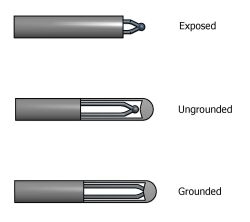Shop by Category
How to Choose a Thermocouple
Which Thermocouple Do You Need?
When selecting a thermocouple, the following items need to be considered: temperature range, reaction time, abrasion / vibration resistance, chemical resistance, calibrations, installation and compatibility.
There are many types of thermocouples available in several different calibrations. The most commonly used thermocouples today are K, T, J, E but are also available in other calibrations. Each calibration offers a specific temperature range and is selected carefully for the environment in which it is to be used.

Operating Range Per Calibration Type:
Operating Temperature
(Check Sheath Temperature Rating)Each Conductor J 0 - 900° C
(32 - 1650 ° F)
-200 - 0° C
-(-200 - 32° F)Standard: +/- 2.2°C or +/- .75%
Special Limits of Error: +/- 1.1°C or 0.4%Iron (+) versus copper -45% nickel (constantan) (-) Black K 0 - 750° C
-200 - 0°C
(-200 - 32°C)
(32 - 1380° F)Standard: +/- 2.2°C or +/- .75%
Special Limits of Error: +/- 1.1°C or 0.4%Nickel -10% chromium (+) versus nickel -5% (aluminum, silicon) (-) Yellow E 0 - 1250° C
(32 - 2280°F)
-200 - 0° C
(-325 - 32° F)Standard: +/- 1.7°C or +/- 0.5%
Special Limits of Error: +/- 1.0°C or 0.4%Nickel -10% chromium (+) versus copper -45% nickel (constantan) (-) Purple T 0-350°C
(32-660° F)
-200-0° C
(-325 - 32° F)Standard: +/- 1.0°C or +/- .75%
Special Limits of Error: +/- 0.5°C or 0.4%Copper (+) versus copper -45% nickel (constantan) (-) Blue
Thermocouple Material selection
All Temprel MgO insulated thermocouples are made using the highest purity MgO for temperatures up to 2300°F (1260°C). The thermo-elements are all ANSI special limits of error to give your measurements the best possible results. The various sheath materials are dependent on the application and the following will help you make the best selection.
304 SS Maximum temperature of 1650° (900°) and is the most widely used low temperature sheath material. It offers good corrosion resistance but is subject to carbide precipitation in the 900°F to 1600°F (480 to 870°) range.
310 SS Maximum temperature of 2100°F (1150°C) and offers good mechanical and corrosion resistance similar to 304SS. Very good heat resistance. Not as ductile as 304SS.
316 SS Maximum temperature of 1650°F (900°C) and has the best corrosion resistance of the austenitic stainless steels. Subject to carbide precipitation in the 900°F to 1600°F (480 to 870°C)
Inconel® Maximum temperature 2150°F (1175°C) and is the most widely used thermocouple sheath material. Good high temperature strength, corrosion resistance and is resistant to chloride-ion stress corrosion, cracking and oxidation. do not use in sulfur bearing environments.
Hastelloy X Maximum temperature 2200°F (1205°) widely used in aerospace applications. Resistant to oxidizing, reducing and neutral atmospheric conditions. Excellent high temperature strength.
| Standard Sheath Diameters | Suggested Upper Temperature Limits |
| .020" + .001 - .0005" | 1290°F (700°C) |
| .032" = .001 - .0005" | 1290°F (700°C) |
| .040" + .001 - .0005" | 1290°F (700°C) |
| 0.63" ± .001" | 1690°F (920°) |
| .090" ± .001" | 1830°F (1000°C) |
| .125" + .002 - .001" | 1960°F (1070°C) |
| .188" + .002 - .001" | 2100°F (1150°C) |
| .250" + .003 - .001" | 2100°F (1150°C) |
Selection of the Measuring Junction
Sheathed thermocouples are available in 3 junction types: grounded, ungrounded, and exposed. Each design offers specific advantages as well as disadvantages and must be considered carefully when placing an order.

Grounded Junction
The thermo-elements are welded into the end cap using the same weld rod as the sheath material. Fast time response. Recommended
for high pressure applications, liquids, moisture, contaminating atmospheres, and most general uses.

Disadvantage: Can Be subject to EMF interference.
Ungrounded Junction
The thermo-elements are welded together and are electrically isolated from the sheath. Recommended for applications where stray EMF's from electrical apparatus would affect the reading.

Disadvantage: Slower Response Time.
Exposed junction
The thermo-elements are welded together outside of the sheath. This provides the fastest time response, but exposes the elements to contamination. Electrically isolated from the sheath. 
Disadvantage: Cannot be used in an environment with a high percentage of solids, high pressure, or liquid material since the junction is exposed to this environment.
Response times
Values are for 2/3 of total temperature change from 0 to 100% as measured in water. 20-AWG bare wire junction measured in gas.
| Outside Diameter | Approximate Wire Gauge | Approximate Wall Thickness | Grounded Junction | Ungrounded Junction |
| .020 | 38 | .003 | .02 | .03 |
| .032 | 34 | .004 | .02 | .07 |
| .040 | 32 | .006 | .04 | .13 |
| .062 | 28 | .009 | .22 | .40 |
| .090 | 25 | .012 | .33 | .68 |
| .125 | 22 | .017 | .50 | 1.10 |
| .188 | 19 | .025 | 1.00 | 2.30 |
| .250 | 16 | .033 | 2.20 | 4.10 |
Learn More About Our Thermocouple Models




